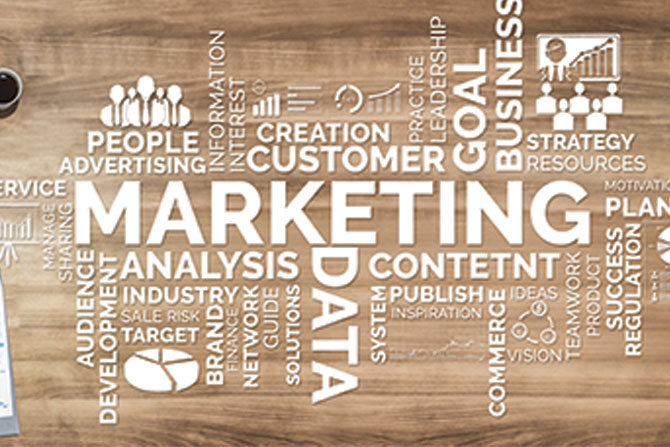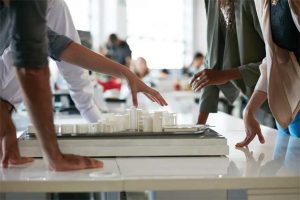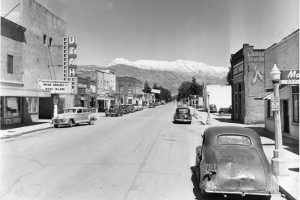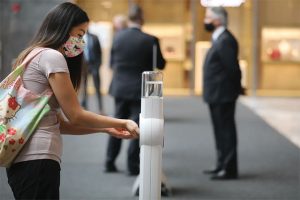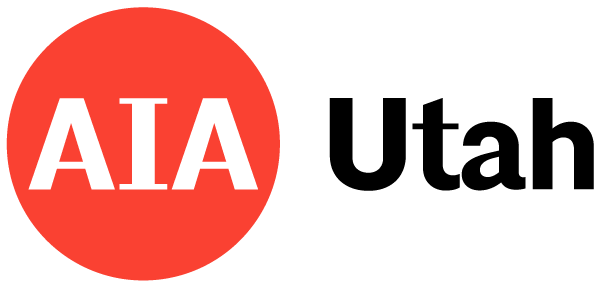By Fran Pruyn, CPSM, Corporate Secretary and Chief Marketing Officer, CRSA Architecture
Across the world, COVID-19 has ripped through economies. Many small businesses are in peril; 20% to 80% of restaurants are not expected to survive. The airlines are predicting record layoffs in the Fall.
Here in Utah, like usual, the impacts are not quite as dire. And, because of the nature of their work, architects are still waiting for the other shoe to drop. Our projects are long; big projects the last few years. The upside of this is that most of us are busy, still benefiting from the hitherto vigorous economy. Yet, institutions HAVE canceled projects that were in early stages — are they the canaries in the coal mines or just a blip? Where are the new projects? Will they just start up a little later when everything is, “back to normal”?
Of course, nobody knows.
We do know that the economy was virtually shut down for a couple of months, is still sputtering along, and that certain sectors are suffering. That is bound to take a toll, at least in the short term, and probably for a while. But, in Utah, for architects, could that be a blessing in disguise? So many of us were laboring under heavy workloads and labor shortages, maybe this will give us a little reprieve, to slow down a little and catch up on our backlogs. The optimistic view is that we can ride this out — there will be new work when we need it. Maybe.
Since we have no hard end date for all this, as researchers continue to look for a vaccine and the country continues the current turbulent political ride, smart A/E/C marketers are thinking strategically. To do that, we need to review the status of things right now and decide where to put our efforts for the next 6-18 months.
Clients:
- Interest rates are low, money is cheap and developers are
taking advantage. - The feds have not issued any stimulus money. Work, as always at the federal level, is slow to roll out, and we are all holding our collective breaths to see where federal money might go in the next year or two.
- The State of Utah has canceled most of its capital development projects funded during the 2020 session. There are capital improvement projects, but those are small and mostly non-architectural. Sometimes institutions and departments have discretionary money. Will this money be reallocated in the next session?
- Salt Lake County has put all of its capital projects on hold. The County has a lot of facilities to keep going, and some of them are not generating any income.
- Many municipalities are struggling under the weight of the severely decreased tax base.
- Some agencies continue to issue RFPs for money that was allocated in 2019 or early 2020. Is it time to jump on those?
- Southern Utah is still enjoying a full-bodied private sector.
- Nonprofits, including churches, are experiencing cash flow problems from decreased giving.
- Some CIB funding may be redirected.
- Downtown Salt Lake City, being deprived of a large daily workforce, conferences, entertainment and national visitors, is desperate to find new ways to get locals downtown.
- The PPP has been a great boon to private industry but expires in the Fall.
- Consumer confidence in safety measures has remained low, particularly in more urban environments, like Salt Lake City.

In specific market sectors:
- There are still housing projects going on all over the state. As a result of in-migration and our birthrate, there is still a housing shortage.
- Healthcare is exploring new models but needs modern facilities to accommodate the latest research and technology, now more than ever.
- Hospitality is at about 21-25% occupancy — but there are still
some hospitality projects slowly moving ahead. - Offices: As of late August, only 22% of the workforce had returned to their downtown offices. Those office buildings that have national tenants had only 5% of their workforce in residence; 50% of suburban workers are back in the office. New office towers are going up in downtown Salt Lake City. According to CBRE, 920,000 s.f. of space is under construction. This is concerning considering the additional sublease space available. Can they be filled?
- More office: Some workers say they plan to work from home, at least part-time, indefinitely. How this plays out in terms of what clients need will be better determined when more people return to the office. Short term, they will need to make accommodations that might require architectural solutions. Long term, will they want more space and more distancing, or less as there will be more people working flexible schedules? What is the future of large conference rooms? Once the COVID crisis has passed, will we go back to the way we were when we were all in the office — or will we want more space? Let’s face it — we have been making each other sick with something or other for years.
- Retail was challenged before COVID-19, as so much shopping has gone online. On the flip side,
big merchandisers like Walmart and Costco are doing great. Often these
are national firms that just need
site accommodation for their
template designs. - Industrial work — particularly warehousing and distribution centers — remains strong and in demand. This is work that genuinely cannot be done from home.
- K-12 — Will we need bigger classrooms? Will FF&E need redesigns? What about playgrounds? What will we have learned in a month, six months, a year? Where will the money come from if the tax base remains depleted? What does this mean in Utah, where we have large families and larger class sizes?
- Higher Ed Engineering is thriving, and so is STEM, but all campuses keep an eye on their enrollments and their “3rd-week census data.” They have taken a hit once, and don’t know how much learning will be in-person or online and for how long.
- High Tech — well duh. Apple just became the first $2 trillion company. Silicon Slopes still seems to be active.
I could go on with specifics that are good on September 16 but will be dated by the time this is published. But here are the takeaways for me, as a marketer for an architectural firm in Salt Lake City in 2020.
Keep your clients happy. Yeah, that is always the case, but now more than ever. If a client only has a few projects to award, they will go to the designers they trust, that they know will take care of their budgets, schedules, and jobs.
Make sure they are happy. It is easy to think your clients are happy when they are really just being nice. It is the Utah way. Check in on them, or better yet, have someone who doesn’t have much vested in the project check in on them.
Be very strategic. It isn’t easy to just become a healthcare specialist or to know overnight what tech companies need or want in their offices, their hardware plants, or their distribution facilities. Align your experience with your pursuits; then hire strategically to expand your experience base. Sometimes you can learn on the job or find a way in through a client who is attracted to your work or your smile or your brother-in-law. That is less likely if things get tight, and their job is on the line if they mess up by hiring you.
Assume that there will be more, smaller jobs with specific clients and go after them. Now, not when you need them in six months.
Don’t assume that marketing is an unaffordable overhead. There was a time that all an architect needed was a handshake and a business card. Most firms have very sophisticated marketing departments, and in SLC, there are a ton of talented designers.
Be imaginative. You are architects. Now is the time to find new, better ways to do things. Make yourselves invaluable. Think up something new, not just a new design (which is always terrific), but a better QC system or another way to track RFIs, or a communication plan that leaves nothing to chance.
Hopefully, none of this is necessary, and this whole pandemic thing is just going to be a bump in the road. I am confident that the Utah economy WILL return to its robust self — and maybe sooner than later. But at some point, if not now, then soon, a downturn will come, and we all will need to be smart, strategic, and innovative. Remember, health crises at the turn of the last century — TB, Spanish Flu, Cholera — were major catalysts for modernism. So maybe this is your opportunity to do something that really rocks Utah. Maybe the world.
Fran Pruyn, CPSM, Corporate Secretary and
Chief Marketing Officer, CRSA Architecture
This story appears in Issue 1 2020-2021 of the Reflexion Magazine.

